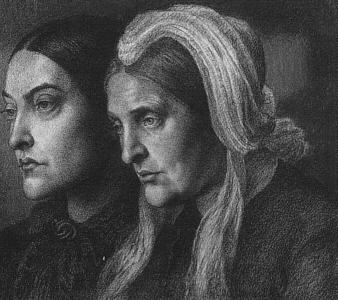Executed when he was 20 years old, and shown at the Free Exhibition that opened on 24 March 1849, this was Rossetti's debut painting and the first to bear the P.R.B. initials in public. It was well received by critics and was sold for £80 to the Dowager Marchioness of Bath as a result of the intervention of Rossetti's aunt Charlotte Polidori, who had been her governess and was later her companion. The style is less naturalistic than the work of Rossetti's contemporary Pre-Raphaelite artists, being likened to 'Early Christian Art' by Ford Madox Brown. Brown supervised the painting with Holman Hunt, who shared Rossetti's Cleveland Street studio.
The Girlhood of Mary Virgin is steeped in religious symbolism. The seven-leaved palm branch on the ground is tied to a seven-thorned briar by a scroll, the inscription on which predicts the forthcoming Passion of Christ. There is a cross in the lattice work; a dove, symbolic of the Holy Spirit; and a red cloak representing the Robe of Christ. The vine signifies the sacrifice of Christ's life. The titles of the six large books stacked on the ground represent the three cardinal virtues and three of the theological virtues although Justice was omitted. Rossetti explained the subject in an 1848 letter to his godfather Charles Lyell:
'The subject is the education of the Blessed Virgin, one which has been treated at various times by...other painters...they have invariably represented her as reading from a book under the superintendence of her mother, St. Anne... In order, therefore, to attempt something more probable and at the same time less commonplace, I have represented the future Mother of our Lord as occupied in embroidering a lily always under the direction of St Anne; the flower she is copying being held by two little angels.'
The original intention to include two angels was rejected because of the problematic child model, and, as it was, the angel's head was repainted in July 1849. Christina, Rossetti's sister, sat for Mary; his mother for Saint Anne; and Old Williams, a family handyman, stood patiently in an uncomfortable pose with upraised arms as Saint Joachim. The identities of the figures are inscribed in gilt haloes above their heads. As portraits of the sitters, these were considered very accurate. Two sonnets, printed on gold paper, were attached to the frame of the picture and are now on the back. Amendments were made in 1864 when Rossetti borrowed the Painting from its then owner, Lady Louisa Fielding, who was given it by her mother, the Marchioness of Bath.
The models for this painting- Christina, his sister and a well-known poet, and his mother Frances, are immortalized also in the following drawing:

|
Return to the Rossetti page

